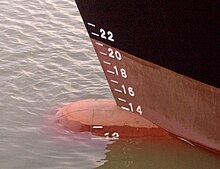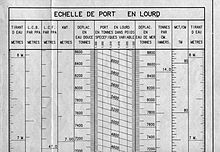
Back حمولة ساكنة Arabic Detveyt Azerbaijani Дедуейт Bulgarian Tonatge de pes mort Catalan DWT (jednotka) Czech Dødvægt Danish Deadweight Tonnage German Νεκρό φορτίο Greek Tonelaje de peso muerto Spanish Dedveit Estonian


Deadweight tonnage (also known as deadweight; abbreviated to DWT, D.W.T., d.w.t., or dwt) or tons deadweight (DWT) is a measure of how much weight a ship can carry.[1][2][3] It is the sum of the weights of cargo, fuel, fresh water, ballast water, provisions, passengers, and crew.[1]
DWT is often used to specify a ship's maximum permissible deadweight (i.e. when it is fully loaded so that its Plimsoll line is at water level), although it may also denote the actual DWT of a ship not loaded to capacity.
- ^ a b Turpin, Edward A.; William A. McEwen (1980). Merchant Marine Officers' Handbook (4th ed.). Centreville, Maryland: Cornell Maritime Press. pp. 14–21. ISBN 0-87033-056-X.
- ^ Hayler, William B. (2003). American Merchant Seaman's Manual (7th ed.). Centreville, Maryland: Cornell Maritime Press. p. G-10. ISBN 0-87033-549-9.
- ^ Gilmer, Thomas C. (1975). Modern Ship Design (2nd ed.). Naval Institute Press. p. 25. ISBN 0-87021-388-1.
© MMXXIII Rich X Search. We shall prevail. All rights reserved. Rich X Search